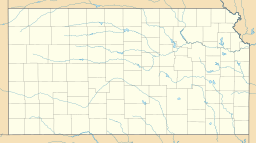Neosho State Fishing Lake facts for kids
Quick facts for kids Neosho State Fishing Lake |
|
|---|---|
| Lake McKinley | |
| Location | Neosho County, Kansas |
| Coordinates | 37°25′26″N 95°11′58″W / 37.4238°N 95.1995°W |
| Type | artificial lake |
| Surface area | 92 acres (370,000 m2) |
Neosho State Fishing Lake, also known as Lake McKinley, is a popular spot in Neosho County, Kansas, United States. This artificial lake was created for people to enjoy fishing, camping, and picnics. You can find it about 5 miles (8.0 km) north and 4 miles (6.4 km) east of the city of Parsons.
About the Lake
Neosho State Fishing Lake was finished in 1927. It covers about 92 acres (370,000 m2) of water. Around the lake, there are 124 acres of land that everyone can use. This area is perfect for outdoor fun and relaxation.
Fun Activities
Many people visit Neosho State Fishing Lake for its great activities.
- Fishing: It's a top spot for fishing.
- Camping: You can set up a tent and stay overnight.
- Picnicking: There are picnic tables and barbecue grills for outdoor meals.
The park also has a shelter house, which is a covered area for groups. You'll find fishing piers that let you get closer to the water. Restrooms, called vault toilets, are also available for visitors.
Youth Fishing Pond
Below the main Lake McKinley dam, there's a special pond just for young anglers. This "catch and release" pond is for kids aged 15 and under. They must be with an adult to fish there. It's a great place for kids to learn how to fish.
Lake McKinley's History
This lake was named after Marshall Coleman McKinley. He was a person from Parsons who cared a lot about protecting nature. People like him are called conservationists.
Mr. McKinley was the president of the local Izaak Walton League chapter. This group works to protect natural resources. He asked the Kansas State Fish, Game and Forestry Commission to build the lake. He also asked them to create a fish hatchery there. A fish hatchery is a place where young fish are raised before being released into lakes and rivers. His efforts led to the creation of this wonderful lake. Today, the Kansas Department of Wildlife and Parks manages the lake.


